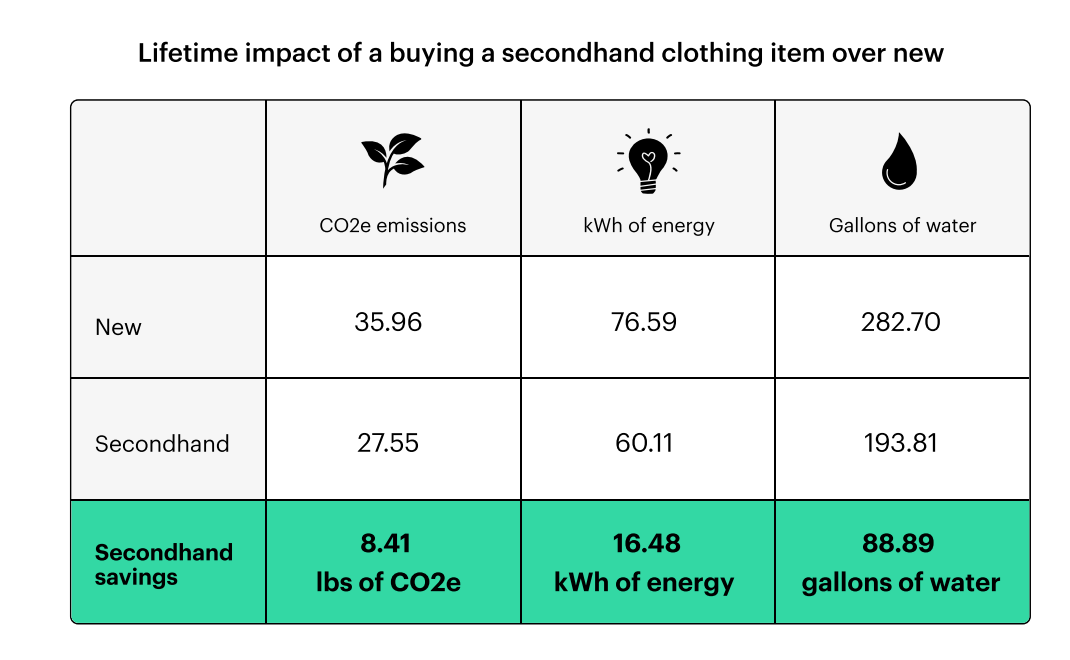How We Calculate Impact at Beni
As with any person or company, Beni has an impact on the environment. Our goal is to have the biggest net positive impact possible. On the positive side, the Beni extension is designed to reduce the burden of fashion on the planet by increasing the percent of purchases that are made through resale, which are shown to have a lower net impact on the planet than new purchases (see below). This said, as a company, we also use resources and impact the planet through operations (i.e. using energy for servers, traveling for events, etc). As we grow our product and company, our goal is to evaluate and communicate Beni’s impact as holistically as possible.
This said, today we only calculate the impact of shifting purchases from new to resale. To calculate this impact, we currently leverage existing research conducted by Green Story & thredUP which uses a life cycle assessment (LCA) methodology. This LCA compares the impact of buying used clothing versus buying an equivalent item new. If you want to learn more about the nuances of the LCA assessment (and the impact of resale in general), check out this blog post.
OK, ok, so what does this LCA thing say?
The most recent analysis shows that buying and wearing secondhand clothing instead of new reduces carbon emissions by an average of 25%:

This average is generated from the impact calculated for 15 categories, listed below (I know, it’s a lot of numbers):

Source: GreenStory, “A Comparative Life Cycle Assessment (LCA) of Resale vs Linear Clothing Systems”, 2022
Take note that certain categories have a bigger potential environmental savings from reuse. This is because garments differ in the amount of resources used in production, the likelihood that a secondhand purchase displaces a new purchase, and in how long the garment can and is used. Think of the equation like this:
Potential savings from reusing a product = (Production impact + Retail impact + End of life impact) * Replacement rate* Displacement rate – Resale operations
There is a lot of nitty gritty in assumptions regarding the replacement and displacement rates, but the gist is that (a) buying something resale is much better for the planet if it actually displaces a new purchase and (b) the longer a garment can and is used before being replaced, the lower the carbon footprint per wear because you divide the initial production impact by a larger number of uses.
Phew! There is a lot of nuance in calculating impact, and we haven’t even scratched the surface. The biggest takeaway is that we can have a big impact on the planet by shifting purchases to resale and keeping garments in use for as long as possible. That’s a pretty big deal! Our goal with Beni is to make the opportunity to switch to resale as convenient and accessible as possible.
Going forward, we are excited to expand and deepen how we capture and calculate our impact so that we can be sure to have the biggest net positive impact on the planet as possible. Thanks for being on this journey with us!
----
Some important notes about this analysis:
- This LCA specifically calculates the impact of buying used clothing through thredUP’s model, which is a managed marketplace. Certain aspects of the calculation (i.e. shipping, inventory management) are likely different for other resellers. That said, based on our research we’ve found this LCA to be the most digestible and directionally accurate.
- Displacement Rate: Displacement rate is defined as the estimated portion of new product impact avoided by following a reuse business model. For example, a shopper may purchase 10 reuse garments over the course of a year to add to her wardrobe, but 6 of them were impulse purchases, driven by the lower pricing of the thrift store clothing. In this case then, only 4 of the 10 garments purchased displaced a new garment, resulting in a 40 percent displacement rate.
- Replacement rate: Replacement rates are used to estimate the useful lifespan of the reused product. Generally, assumptions are made in this regard with no evidence. Lifespan of a reused product depends on the first use, functional capacity, and consumers’ attitude. So, in this study consumer attitude and functional capacity based on the industry data were used as a starting point to derive the replacement rates for the studied 15 product categories/garments.



